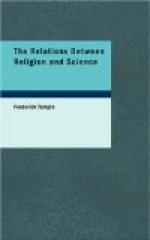Nor, if it was a miracle, can we deny that there was a purpose in it worthy of miraculous interference. For what purpose can rank side by side with the existence and development of life, the primary condition of all moral and spiritual existence and action in this world? In the introduction of life was wrapped up all that we value and all that we venerate in the whole creation. The infinite superiority, not in degree only, but in kind, of the living to the lifeless, of a man to a stone, justifies us in believing that the main purpose of the creation that we see was to supply a dwelling-place and a scene of action for living beings. We cannot say that the dignity of the Moral Law requires that creatures to be made partakers in the knowledge of it, and even creatures of a lower nature but akin to them, must have been the results of a separate and miraculous act of creation. But we can say that there is a congruity in such a miracle, with the moral purpose of all the world, of which we are a part, that removes all difficulty in believing it. Science, as such, cannot admit a miracle, and can only say, ’Here is a puzzle yet unsolved.’ Nor can the most religious scientific man be blamed as undutiful to religion if he persists in endeavouring to solve the puzzle. But he has no right to insist beforehand that the puzzle is certainly soluble; for that he cannot know, and the evidence is against him.
Secondly, if we look at the Darwinian theory by itself, we see at once that it is incomplete, and the consideration of this incompleteness gravely modifies the conclusion which would otherwise be rightly drawn from it, and which, indeed, Darwin himself seems disposed to draw. For the theory rests on two main pillars, the transmission of characteristics from progenitor to progeny, and the introduction of minute variations in the progeny




